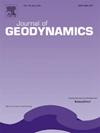Sub-Moho lithospheric modification beneath the western Deccan Volcanic Province adjoining the Konkan plains: Evidence from Magnetotellurics
IF 2.1
3区 地球科学
Q2 GEOCHEMISTRY & GEOPHYSICS
引用次数: 0
Abstract
The western continental margin of India consists of significant geomorphological features, namely the Konkan Coastal Plains (KCP), the coast parallel Western Ghat Escarpment (WGE), and the elevated Deccan plateau covered by massive lava flows, a product of mantle plume – lithosphere interaction. The region has also experienced multiple episodes of rifting. As a result, geophysical characterisation of the crust and mantle lithosphere is necessary to better understand the plume-lithosphere interaction process and its impact on the cratonic lithosphere beneath the western Deccan Volcanic Province (DVP). We present the results from 2-D and 3-D inversion of magnetotelluric (MT) data acquired along a 200 km long profile traversing in E-W direction across the KCP and the western Deccan plateau. The results reveal a distinct change in the regional geoelectric strike direction from N-S in the KCP to NW-SE in the Deccan plateau with the WGE forming the boundary between these two regions. The geoelectric model constructed from 2-D inversion of the MT data yields highly resistive fragmented eastward thickening cratonic blocks of the Dharwar Craton, dissected by faults/fracture zones of pre-eruptive times. The 3-D full-impedance tensor inversion shows similar resistive blocks along with a pronounced low electrical conductivity zone beneath the Deccan Plateau. The moderate-to-high conductivity zones underlying the resistive cratonic blocks possibly represent the relics of the interaction between the Indian lithosphere and the Réunion plume, and a zone of volatiles /long lived sulfide fluids due to the effect of residual thermal anomaly. We interpret this feature as an evidence for lithospheric modification through upwelling and decompressional melting of the volatile-enriched mantle. We infer that the persistent dynamic topography of the WGE is due to the presence of such fluids at the sub-Moho depths and uplifting of a low-to-intermediate strength lithosphere.
毗邻康坎平原的西德干火山省下的亚莫霍岩石圈改造:大地电磁证据
印度西部大陆边缘具有重要的地貌特征,即康坎海岸平原(KCP)、与海岸平行的西高止悬崖(WGE)和被地幔柱-岩石圈相互作用的大量熔岩流覆盖的德干高原高架。该地区还经历了多次裂谷。因此,地壳和地幔岩石圈的地球物理特征对于更好地理解西德干火山省(DVP)地幔柱-岩石圈相互作用过程及其对克拉通岩石圈的影响是必要的。本文介绍了沿横贯KCP和西德干高原的东西向200 km长剖面获取的大地电磁(MT)数据的二维和三维反演结果。结果表明,区域地电走向由KCP的北向南向德干高原的北西-东南方向发生了明显的变化,西格线形成了这两个区域的边界。利用MT数据的二维反演构建的地电模型得到了Dharwar克拉通的高电阻破碎向东加厚的克拉通块体,这些克拉通块体被喷发前的断层/断裂带所切割。三维全阻抗张量反演显示,在德干高原下方有类似的阻性块体和明显的低电导率带。电阻性克拉通地块下的中至高导电性带可能是印度岩石圈与r地幔柱相互作用的遗迹,也是残余热异常作用下的挥发物/长寿命硫化物流体带。我们将这一特征解释为通过富含挥发物的地幔的上升流和减压熔融对岩石圈进行改造的证据。我们推断,西西盆地持续的动力地形是由于这种流体在亚莫霍深度的存在和低至中等强度岩石圈的隆升。
本文章由计算机程序翻译,如有差异,请以英文原文为准。
求助全文
约1分钟内获得全文
求助全文
来源期刊

Journal of Geodynamics
地学-地球化学与地球物理
CiteScore
4.60
自引率
0.00%
发文量
21
审稿时长
6-12 weeks
期刊介绍:
The Journal of Geodynamics is an international and interdisciplinary forum for the publication of results and discussions of solid earth research in geodetic, geophysical, geological and geochemical geodynamics, with special emphasis on the large scale processes involved.
 求助内容:
求助内容: 应助结果提醒方式:
应助结果提醒方式:


